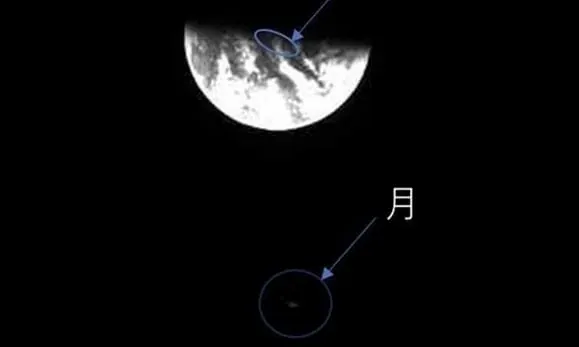
The competition to land on the moon will continue into 2024 as additional government space programs and private enterprises attempt the difficult task.
Because only approximately half of all lunar landing attempts have succeeded without a crash, space lovers are certain to see many magnificent Earth and moon photographs along the road, such as the newest one returned by Japan: Its robotic SLIM mission, which stands for Smart Lander for Investigating the Moon, got a rare image of Earth looming over the moon, but you may need to focus to see it. Japan is circled on Earth in the image, lit at sunrise.
"When the SLIM team first saw this image, they wondered... what is that white dot under the Earth?" JAXA, NASA's Japanese equivalent, said on X (previously known as Twitter) on December 20.

The spaceship was nearly 60,000 miles away from Earth when the photo was taken in September.
SLIM is now far closer to the moon than Earth and will enter lunar orbit in less than a week.
On January 20, JAXA will descend toward the lunar surface for its touchdown. This will place it a few weeks ahead of Astrobotic Technologies' moon landing effort, attempting to transport five NASA sensors, among other payloads, to the surface. The SLIM mission comes after ispace, a private Japanese corporation, failed to land on the moon in April.
According to Jonathan McDowell, an astronomer at the Harvard-Smithsonian Center for Astrophysics, the spacecraft goes farther from the moon in this navigation camera view because of SLIM's specific fuel-saving course.

The SLIM mission launched from Japan's Tanegashima Space Center on September 7 and is scheduled to land near Shioli crater on the moon's near side. Credit: JIJI Press / AFP / Japan OUT / Getty Images
He told Mashable that once the spacecraft reaches a point in space where the gravitational pulls of Earth and the sun are balanced, it will be able to reverse direction without having to resist the pulling forces of either the planet or the star.

"With a tiny spritz of the rocket thruster, you can fall back toward the moon on a path that will pass the moon relatively slowly, allowing you to land easily," he went on to say. "The downside is that it takes several months instead of a few days to get there from Earth."
While the spacecraft takes its time flying around the Earth, the moon continues to do its thing.
"Over several months, the moon whizzes around the Earth several times," he said, "so during this, sometimes relative to SLIM, it's on the same side of the Earth, and sometimes it is on the other side."
The SLIM mission launched from Japan's Tanegashima Space Center on September 7 and is scheduled to land near Shioli crater on the moon's near side. Its goal is to demonstrate a "pinpoint landing" with an accuracy of fewer than 100 yards, a new standard of accuracy for moon landings. The majority of landing targets are many square miles in size.
In August, India became the fourth country to land on the moon, joining an elite group of space-faring nations that included the former Soviet Union, the United States, and China. The achievement occurred just days after the Russian space agency Roscosmos lost its Luna-25 robotic spacecraft, which was orbiting the moon but probably crashed due to a faulty flight maneuver. Both missions were attempting to land their crewless spacecraft around the South Pole region.

Although it has been nearly 60 years since the first unmanned moon landings, touching down remains difficult. The moon's atmosphere is incredibly thin; therefore, there is almost no drag to delay a spacecraft as it approaches the Earth. Furthermore, there are no GPS systems on the moon to aid in the navigation of a vessel to its landing site.
Several nations and private organizations are interested in the moon's south pole because of the ice that is expected to be buried there in permanently shadowed craters. The natural resource is sought because it has the potential to provide drinking water, oxygen, and rocket fuel for future expeditions, bringing in a new era of spaceflight.